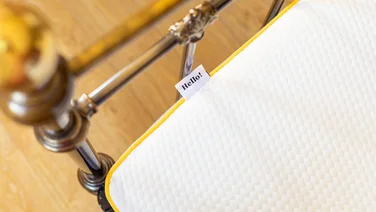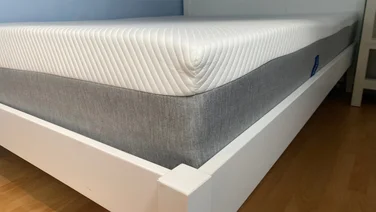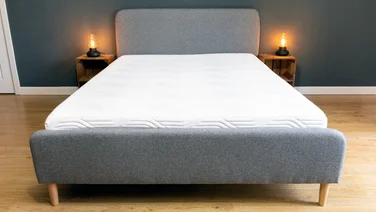To help us provide you with free impartial advice, we may earn a commission if you buy through links on our site. Learn more

Since it first burst onto the scene, memory foam has become one of the most popular materials in the manufacturing of mattresses. This synthetic sponge is engineered to be soft yet supportive. As a result, these comfortable but, more importantly, affordable memory foam mattresses continue to sell exceptionally well in the bed-in-a-box market.
However, could a latex mattress be even better? This naturally derived material is also super-supportive but offers greater breathability and is easier on the environment to boot. Unfortunately, latex is far more expensive, and many latex mattresses command almost double the price of a similar memory foam model.
The market is overstuffed with mattresses, all of them making claims to improve the quality of your sleep, but few of them come cheap. When you’re making such a big investment, it’s important to know it’s going to pay off. Our best mattress roundup does much of the leg work for you; we’ve also got a whole host of other articles to help you on your mattress-buying journey.
So, do the benefits of a latex mattress justify the higher price tag? Or do memory foam mattresses just make more sense? We’ve weighed up the pros and cons of each material to help you make up your mind.
What is memory foam?
You can check out our in-depth guide, ‘What is memory foam?’, for more about this mysterious mattress material but, essentially, memory foam is an artificial sponge-like material. Chemicals are mixed and poured into a mould, then left to cool and set, producing what is known as ‘viscoelastic polyurethane foam’ – an elastic, shape-retaining foam that can be extremely comfortable to lie on.
Memory foam is also used in pillows, like the brilliant Tempur Cloud Pillow – which our reviewer called “life-changing” – and in mattress toppers, like our favourite, the Panda Memory Foam Bamboo mattress topper.
What is latex?
Simply, latex is the white liquid sap of a type of rubber tree. Latex has been used in all sorts of everyday items for decades, from shoes and medical materials to kitchenware and more. When it comes to making mattresses, the natural sap is aerated using compressed air and then set, resulting in a soft, open-cell, foamy material.
Latex mattresses, much like their memory foam counterparts, are known for being soft yet supportive – such as in the super-premium Dunlopillo Millennium Mattress – but they also have many other natural benefits which we will look at below.
READ NEXT: Emma NextGen Premium vs Simba Hybrid Pro
What are the pros and cons of memory foam?
Pros
- Affordable. Since memory foam is produced at scale, the mattresses tend to be far cheaper than latex.
- Soft.
- Highly supportive of pressure points. This is incredibly important for realigning the spine, neck and hips.
- Hypoallergenic. Memory foam mattresses are typically hypoallergenic and, as such, they are resistant to dust mites.
- Quiet. As these mattresses don’t contain springs, they are virtually silent when you roll over during the night.
- Choice. There are many varieties on the market from many different manufacturers, and these manufacturers usually offer generous trial periods for their mattresses.

Cons
- Synthetic. As this material is produced artificially, it can be hard to recycle and must be disposed of responsibly.
- Retains heat. One of the most frequent complaints about all-memory foam mattresses is that they can hold in heat, which becomes uncomfortable, particularly if you tend to sleep hot.
- Off-gassing. New memory foam mattresses often give off an unpleasant smell for the first few days, though this usually dissipates fairly quickly and doesn’t pose any health risks.
- Heavily conforming. For some, the ability of memory foam to mould to your body is a benefit; however, some people dislike feeling so cocooned.
- Not always suitable for heavier people.
- Can become softer in warm environments.
What are the pros and cons of latex?
Pros
- Natural material. The latex used in mattresses is typically all-natural and sustainably produced, making it easily recyclable as well as biodegradable.
- Superior shape retention. Although memory foam is good at springing back to its original form, latex is even better at recovering its shape as you move around in bed.
- Long-lasting. Their lifespan is roughly double most memory foam or pocket spring mattresses, at up to 20 years.
- Cool to sleep on. The open-cell breathable structure is very hygienic and cooling, which is beneficial for hot sleepers.
- Very supportive. Thanks to its shape retention, there’s less conforming and sinking with a latex mattress.
- Hypoallergenic. As with memory foam, latex is hypoallergenic, which is ideal for allergy sufferers.

Cons
- Expensive. Latex mattresses are usually double what you might expect to pay for their memory foam equivalent.
- Heavy. Latex is much heavier than memory foam and so much more difficult to turn or rotate.
- Lack of choice. As it currently stands, there are fewer models available on the market.
- Smell. Sometimes latex mattresses have a rubbery smell that can linger longer than the off-gassing of a memory foam mattress, though this should still dissipate. That said, some people report that all-natural latex actually smells like vanilla.
READ NEXT: Best firm mattresses
Memory foam or latex: Which is better?
Cooling, eco-friendly and longer-lasting – given the choice, many of us would plump for the more obvious benefits of a latex mattress, but they come for a significant price. Memory foam mattresses continue to be extremely popular, and the right model can still revolutionise your sleep, but to enjoy the benefits of both memory foam and latex mattresses without breaking the bank, we would suggest looking at a hybrid.
A mattress like the brilliant Origin Hybrid will tick all the boxes of memory foam plus give you the benefit of a latex layer which we found both aided cushioning and offered enhanced airflow, keeping you comfortable and cool.






